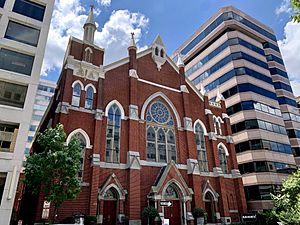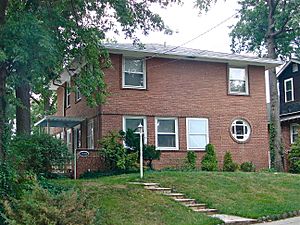List of African-American historic places in Washington, D.C. facts for kids
This list is about important African American Historic Places in Washington, D.C.. These are places that tell the story of African American history in the nation's capital. The information comes from a special book created by groups like the National Park Service and the National Trust for Historic Preservation.
Some of these places are listed on the National Register of Historic Places. This means they are officially recognized as important historic sites. A few are even National Historic Landmarks, which are places of national importance. Other sites have special historical markers in Washington, D.C., to show their significance.
Contents
Northwest D.C. Historic Places
The Northwest part of Washington, D.C., has many places important to African American history.
Important Buildings and Schools
- Andrew Rankin Memorial Chapel, Frederick Douglass Memorial Hall, Founders Library: These buildings are at Howard University. They are key parts of this historic Black university.
- Asbury United Methodist Church: A historic church with a long history in the community.
- Banneker Recreation Center: Named after Benjamin Banneker, a famous African American scientist. This center serves the community.
- Carter G. Woodson House: The home of Carter G. Woodson, known as the "Father of Black History." He started Black History Month.
- Charles Sumner School: An important historic school building. It was one of the first public schools for African American children in D.C.
- Charlotte Forten Grimké House: The home of Charlotte Forten Grimké, a writer and educator who fought for civil rights.
- Freedman's Bank Building: This building once housed a bank created to help newly freed enslaved people.
- Metropolitan African Methodist Episcopal Church: A very old and important church. It's sometimes called "the National Cathedral of African Methodism."
- Freedman's Hospital: A hospital founded after the Civil War to provide medical care for African Americans. It later became part of Howard University Hospital.
- Howard Theatre: A famous theater where many legendary African American musicians and performers played.
- Howard University: A historically Black university. It has educated many important leaders and thinkers.
- Howard University Hospital: A major hospital connected to Howard University.
- Lincoln Theatre: Another historic theater that hosted many Black artists.
- Mary McLeod Bethune Council House National Historic Site: The former home and office of Mary McLeod Bethune. She was a civil rights leader and educator.
- Miner Normal School: An important school for training African American teachers.
- Blanche K. Bruce House: The home of Blanche K. Bruce, who was the first African American to serve a full term in the U.S. Senate.
- Frelinghuysen University, Former Classroom Building: A building that was part of a university for African Americans.
- Lincoln Temple United Church of Christ: A historic church in the Shaw neighborhood.
- Mary Ann Shadd Cary House: The home of Mary Ann Shadd Cary, an early African American newspaper publisher and activist.
- Prince Hall Masonic Temple: A building important to the Prince Hall Masons, an African American Masonic group.
- St. Luke's Episcopal Church: A historic church with a strong community presence.
- Shaw Junior High School: An important school in the Shaw neighborhood.
- Southern Aid Society-Dunbar Theater Building: This building housed a theater and a business that helped African American communities.
- True Reformer Building: An important building for the Grand United Order of True Reformers, a Black self-help organization.
- Twelfth Street YMCA Building: A historic YMCA that provided services for African American men and boys.
- Whitelaw Hotel: A historic hotel that served African American travelers during a time of segregation.
- John Fox Slater Elementary School: An elementary school named after a philanthropist who supported African American education.
- John Mercer Langston School: A school named after John Mercer Langston, a lawyer, educator, and politician.
- Margaret Murray Washington School: A school named after Margaret Murray Washington, an educator and wife of Booker T. Washington.
Historic Neighborhoods and Districts
- Brightwood: A historic neighborhood.
- Military Road School: A school in Brightwood that served African American children.
- Columbia Heights: A neighborhood with historic sites.
- Francis L. Cardozo Senior High School: A high school named after Francis L. Cardozo, an African American educator.
- Downtown: The city center with important places.
- Dupont Circle: A well-known area with historic sites.
- Strivers' Section Historic District: A historic area where many successful African American professionals lived.
- Foggy Bottom: A neighborhood near the Potomac River.
- St. Mary's Episcopal Church: A historic church in Foggy Bottom.
- Georgetown: A very old part of D.C.
- Mount Zion Cemetery: A historic cemetery for African Americans.
- Mount Zion United Methodist Church: A historic church in Georgetown.
- LeDroit Park: A historic neighborhood.
- LeDroit Park Historic District: This area is recognized for its historic homes and community.
- Mary Church Terrell House: The home of Mary Church Terrell, a civil rights activist and suffragist.
- Mount Vernon Square/Convention Center: An area near the city's convention center.
- Shaw: A very important historic African American neighborhood.
- Blagden Alley-Naylor Court Historic District: A historic alleyway and court area in Shaw.
- Truxton Circle: A historic neighborhood.
- U Street Corridor: A famous street known as "Black Broadway" for its vibrant African American culture and businesses.
Northeast D.C. Historic Places
The Northeast section of D.C. also holds many significant African American historic places.
Notable Homes and Institutions
- Brentwood: A neighborhood in Northeast D.C.
- Ralph Bunche House: The home of Ralph Bunche, the first African American to win the Nobel Peace Prize.
- Brookland: Another historic neighborhood.
- Sterling Brown House: The home of Sterling Brown, a famous poet and professor.
- Carver Langston: A community named after George Washington Carver and Langston Hughes.
- Langston Terrace Dwellings: An early public housing project designed by an African American architect.
- Fletcher Chapel: A historic chapel.
- Nannie Helen Burroughs School: A school founded by Nannie Helen Burroughs, an educator and civil rights activist. It trained African American women.
- Young, Browne, Phelps and Spingarn Educational Campus Historic District: An area with several important educational buildings.
Historic Districts and Sites
- Langston Golf Course Historic District: A golf course that was important for African American golfers during segregation.
- Kingman Park Historic District: A historic neighborhood.
- Mayfair: A community in Northeast D.C.
- Mayfair Mansions Apartments: Historic apartment buildings.
Southeast D.C. Historic Places
The Southeast part of Washington, D.C., has its own important historic sites.
Key Sites and Neighborhoods
- Anacostia: A historic neighborhood.
- Anacostia Historic District: This area is recognized for its unique history and community.
- Frederick Douglass National Historic Site: The former home of Frederick Douglass, a famous abolitionist and writer.
- John Philip Sousa Junior High School: A school named after the famous composer.
- Navy Yard: An area near the Anacostia River.
- Saint Paul African Union Methodist Church: A historic church in the Navy Yard area.
Southwest D.C. Historic Places
The Southwest section of D.C. also has places that tell important stories.
Significant Locations
- Friendship Baptist Church: A historic church with a long history in the community.
- Lincoln Memorial: While a national monument, it is also a very important site for African American history. It was the location of Martin Luther King Jr.'s "I Have a Dream" speech.
- William Syphax School: A historic school building.
Other Important Locations
Some other significant places are found throughout D.C.
- Camp Greene on Theodore Roosevelt Island: A historic camp site.
- Evans-Tibbs House: A historic house.
- Gen. Oliver Otis Howard House: The home of General Oliver Otis Howard, who helped found Howard University.
- M Street High School: An important early high school for African Americans in D.C.
- Phillis Wheatley YMCA: A YMCA named after Phillis Wheatley, an early African American poet.
- True Reformer Building: This building is also listed in the Northwest section, showing its importance to different parts of the city's history.
See also
- List of artworks commemorating African Americans in Washington, D.C.
- History of Washington, D.C.
- Timeline of Washington, D.C.



